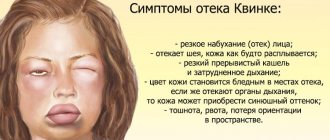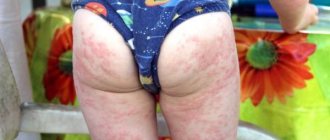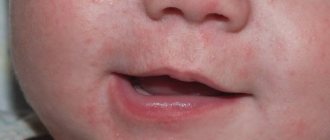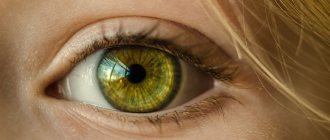Food allergic reaction
Today, the following types of allergies are distinguished, which are accompanied by various clinical signs on the body.
A food allergy in the body is an immunologically mediated (type I/III) reaction to allergens that enter the body through food.
The most common triggers are cow's milk, fish, nuts, chicken eggs, cocoa, and food coloring added to sweets.
Symptoms of food allergies vary, but most often include rashes, red spots, hives, and itching of the skin (face and body).
In most cases, food allergies are accompanied by the development of urticaria (urticaria).
Urticaria (urticaria) is a skin disease, the main feature of which is itching and the development of rashes on the surface of the skin.
Triggers for aggressive skin reactions can be varied.
All people are susceptible to developing allergic urticaria, regardless of race or age.
In most cases, acute spontaneous urticaria is observed, which occurs completely suddenly and disappears after a few days.
Antihistamines and intestinal sorbents will help speed up the healing process.
If allergy symptoms on the body last longer than six weeks, we should talk about chronic urticaria.
Urticaria can be recognized by the following symptoms:
- It appears in the form of bright pink spots, up to 2 cm in diameter, sometimes more. The spots do not have a clear shape and can merge into larger lesions.
- The localization of spots can change, migrating from one area of the skin to another. Also, allergies can spread throughout the body, both in adults and children.
- It appears suddenly, a few minutes or an hour after contact with the allergen, and can also disappear suddenly.
If we are talking about chronic urticaria, then the skin manifestations of the reaction are complemented by a deterioration in general health, fever, and signs of asthma.
Quite rarely, sudden and painful swelling of the deeper layers of the skin (lower dermis and subcutaneous layer), called angioedema, may occur.
This allergy can cause swelling and itching of the entire body.
Allergy in a child in the form of red spots
Allergic spots appear especially often in young children. Moreover, the reaction can appear completely suddenly and on any part of the body. The reason should be, first of all, looked for in the menu of a baby or a nursing mother. The child's body instantly reacts to unusual foods or familiar ones, but in too large quantities.
If red spots appear on the child’s face, arms, legs, or in the groin area, they itch, peel, and begin to become wet, this may be diathesis. It develops as a result of malnutrition, food allergies, hormonal imbalance, and also due to improper functioning of the body.
Contact allergies occur when there is direct contact with an allergen. It could be washing powder, after which you didn’t rinse your laundry, synthetic or even woolen fabrics well. In this case, spots appear on the palms, cheeks and other parts of the body with which the baby came into contact with an aggressive surface.
Even after stopping contact with the irritant, spots on the skin remain for several days. If they cause discomfort to the baby, then the affected areas must be especially carefully cared for. In addition, constant itching causes scratching, which can become infected, and then serious skin treatment will be needed.
When the cause is not an allergy
Red spots on the skin do not only occur as a result of an allergic reaction.
- Infectious diseases make themselves felt at the development stage in the form of rashes on the body. They usually cover a large area of the dermis and are accompanied by an increase in temperature. Such diseases include chickenpox, measles, scarlet fever, rubella, ringworm, meningitis, and typhoid fever.
- Diseases of internal organs often manifest themselves in the form of skin rashes. The appearance of a red rash may indicate vegetative-vascular dystonia, disorders of the nervous system, an unhealthy stomach, heart, or the presence of tumor diseases.
- Dermatological nature of the rash. Most skin diseases manifest themselves in the form of skin hyperemia, expressed by obvious redness and itching. The most common cases are eczema, psoriasis, dermatitis, lupus erythematosus, seborrhea, and lichen.
Medicine knows more than fifty diseases that are accompanied by a similar symptom. Therefore, accurate diagnosis is very important, and only a specialized dermatologist can carry it out after a series of tests. He will also determine the exact allergen, if the cause of the appearance of red spots is still in it, and prescribe the appropriate treatment.
Allergy to cosmetic ingredients
Allergies to cosmetics are usually associated with a delayed type IV reaction.
Symptoms include redness, itching, peeling, burning sensation on the skin, and blisters.
Clinical signs usually appear within 24-72 hours.
But there are times when an allergy, for example, to a body scrub or cream, appears after an hour or two.
Typically, an allergic reaction is limited to the area of skin that has been in direct contact with the allergen.
In principle, any cosmetic ingredient can cause allergies or intolerances.
The most common triggers include various herbal additives, preservatives, lanolin, and emulsifiers.
Whether a certain preservative or other additive can cause an allergy depends on various factors.
First of all, it depends on the individual characteristics of the person and on the quality of the products produced.
It should also be taken into account that the manifestation of allergies is partly genetic.
Frequent contact with water and the use of aggressive cleaning agents can also contribute to the development of an allergic reaction.
When using chemicals, allergies often manifest themselves as pimples on the body.
It is a myth that natural cosmetics do not cause allergies.
Many cosmetics, such as natural cosmetics, use plant extracts.
They contain irritating and/or sensitizing substances.
So incompatibility and allergy reactions are also possible here.
Cold allergy
Cold urticaria is a rare disease that occurs in approximately 2-3% of cases.
The reaction is caused by cooling of the skin or mucous membranes upon contact with air, water, cold objects or frozen foods.
Cold urticaria appears quickly.
Accompanied by progressive itching, erythema (redness) and swelling of the skin after contact with cooled substances.
Sometimes, the first symptom is a burning sensation of the skin.
Clinical signs occur mainly in areas that have been exposed to cold.
But sometimes they can spread throughout the body.
Symptoms usually go away on their own after a few hours or a few days.
Allergy to cold with typical symptoms on the body manifests itself during exposure to the following factors:
- Low air temperature, cold wind, rain.
- Staying in cool water or walking barefoot on a cold floor.
- Drinking cold drinks and food.
The diagnosis of cold urticaria is made based on the results of the anamnesis and diagnostics.
To confirm the reaction, a test is carried out using an ice cube.
The test is performed by placing ice wrapped in a plastic bag on the forearm for 5-20 minutes.
The test is considered positive when symptoms develop within 15 minutes after the start or end of testing.
It's worth noting that about 20% of people with cold urticaria have a negative ice cube test.
Drug allergy
Signs of allergies on the body can range from mild discomfort to life-threatening conditions.
The most common pharmacological substance that causes allergies is penicillin.
Other triggers that may cause reactions (that are not related to IgE antibodies) include the following:
- Sulfate preparations
- Anticonvulsants
- Nonsteroidal anti-inflammatory drugs
- Some types of food coloring (usually red and yellow)
- Chemotherapy drugs
Clinical signs of allergic reactions may be accompanied by mild itching of the skin, redness, and rash.
When identifying allergies to certain medications, it is important not to confuse them with side effects.
They may be accompanied by hives, rashes, and stomach upset.
Particular attention should be paid to cases where drug allergies on the body develop in pregnant women.
It is necessary to stop signs of the reaction as soon as possible.
Allergists often make a diagnosis based only on medical history and associated symptoms.
This is what in practice is called a “clinical diagnosis”.
In many cases, patients may have an allergic reaction when taking multiple medications at the same time.
In these cases, if the doctor cannot identify the true allergen, a comprehensive examination is additionally prescribed.
During the diagnostic process, your doctor will recommend stopping all medications.
Allergy to pets
Animal allergies are the third most common allergy after pollen and house dust intolerance.
Characteristic symptoms are sneezing, runny nose and itching.
In the worst case, allergic asthma may develop.
A pet allergy is an intolerance to certain substances found in your pet's saliva, dander, sebum, urine and feces.
In this case, the animal’s fur is not responsible for the manifestation of an allergic reaction.
Therefore, a person can also be allergic to birds.
Triggers of the immunopathological process can be a variety of animals.
Both small ones - cats, dogs, guinea pigs, and large ones - horses, cattle, etc.
Upon contact with an allergen, various reactions may occur on the part of the epidermis - allergic or contact dermatitis.
For example, if you are allergic to a cat, contact rashes may occur on your body after touching the animal.
Direct contact with a pet may cause the following signs and symptoms:
- red spots on the skin (urticaria);
- eczema (inflammation of the upper layers of the dermis);
- itchy skin and small rashes.
Almost always, skin reactions are accompanied by sneezing, itching in the nasal cavity, redness of the mucous membranes of the eyes, and nasal congestion.
Cat and dog allergens are present in epithelial cells.
The main source of cat allergens are the anal glands; In dogs, the trigger is saliva.
Allergies in the form of red spots: causes of appearance and localization
Regardless of the nature of the skin rashes, they should alert you. In any case, this is a signal from the body to any internal problems or to external influences. And in the case of allergies, the most important thing is to eliminate its source. This is why it is important to understand that red spots on the face or body are allergic in nature.
The main causes of allergies and red spots include:
- Reaction to external irritants: allergies to household chemicals, cosmetics, animal hair, plants are most often accompanied by the appearance of red spots directly at the sites of contact with the allergen (also called contact dermatitis). The skin of the hands, feet, face, and neck suffers.
- Long-term use of medications, especially antibiotics, can also provoke an allergic reaction. Locations of allergies and the red spots that accompany them can be found throughout the body.
- Food allergies to certain allergenic foods and poor nutrition in general often cause the appearance of red spots in the abdomen, face, arms and legs. This reaction also occurs with vitamin deficiency or hypervitaminosis, i.e. when there are not enough vitamins or too many of them.
- Nervous exhaustion, stress, and unstable emotional state also affect the condition of the skin. If you have recently experienced a strong outburst of emotions, after which you noticed red spots on your body, this is a reason to consult a dermatologist and neurologist.
- The skin is irritated and red from allergies to cold and sun. More often, its manifestation is noticeable in areas of the skin that are most exposed to weather conditions due to the fact that they are not protected by clothing - these are the hands and face.
Allergy to alcoholic beverages
True alcohol allergy, in which the body produces an IgE antibody in response to alcohol, is very rare.
Alcohol intolerance is more common.
The symptoms of a true alcohol allergy are similar to the symptoms of an immunopathological process that occurs in relation to food (food allergy).
An allergy to alcohol can cause red spots on the body (hives), rashes, itching, tingling in the mouth, swelling of the lips, tongue, and difficulty breathing.
An allergy to alcohol poses a particular danger to humans.
For some patients, drinking 10 ml of ethanol results in anaphylactic shock.
Although true allergies to ethanol are rare, alcoholic beverages can contain a number of different ingredients that can cause allergy or intolerance symptoms.
These can be various herbal additives, dyes, etc.
Alcohol allergy should be differentiated from intolerance.
It is accompanied by headache, nasal congestion, rapid heartbeat, nausea, vomiting, heartburn, abdominal pain, and a small rash on the body (usually on the face).
Those with an alcohol allergy must not only abstain from all alcoholic beverages.
But you should also be aware of other foods that may contain alcohol and avoid them.
For example, liquor in candy can be extremely dangerous for a person with a similarly sensitive immune system.
Symptoms of different types of allergies
08.10.2021
A person who has been suffering from this disease for a long time can easily identify the first signs of an allergy . But if the disease began recently, you should learn to distinguish allergic symptoms from other painful manifestations. Additionally, the symptoms listed may identify the product or substance that is causing the immune .
Symptoms of allergies to cat and dog hair
Symptoms allergies include hives and redness. In addition to reactions to pet dander, allergens are also found in the animal's saliva, urine , and dead epidermal cells. Therefore, symptoms of the disease may also appear at the site of a bite or scratch.
- prolonged dry cough
- breathing vibration occurs when you take a deep breath
- hoarseness of voice
- nasal congestion , runny nose , rhinitis
- nasal discharge
- eye irritation
- lacrimation
Allergy to cold and its symptoms
allergy symptoms become stronger with constant contact with cold water or being outside in winter, then talking about cold allergy It should be borne in mind that an allergy to cold is not an independent disease, but signals serious disorders of the immune or endocrine systems. The following symptoms may indicate an allergy to cold:
- swelling of exposed parts of the body (arms, face , neck )
- redness and itching of the skin
- dry and flaky skin
- pink rash on face and chest
- burning of the skin of exposed areas of the body
- headache
- lowering blood pressure
- difficulty breathing
- sore throat , itching in the nose , ears .
Allergy to dust or household chemicals
This type of allergy affects most young children and adults who have a hereditary tendency to allergic diseases, as well as people suffering from a chronic form of this disease. For such people, any speck of dust or any particle of any chemical substance will be perceived by the immune system as an allergen and symptoms will appear, such as:
- allergic rhinitis , sneezing
- purulent conjunctivitis
- asthma , difficulty breathing
- nasal discharge
- scabies and burning sensation in the nose and throat
- headache, lacrimation
- redness of the whites of the eyes , blurred vision
- inflammatory processes of the respiratory tract
This type of allergy can also be caused by household mites and their waste products, as well as dead cells of their epidermis.
Food allergy and its symptoms
A food allergy is an excessively expressed immune response of the body to food components, usually proteins. Symptoms of an allergic reaction can range from mild to severe. A reaction to any food component appears immediately after eating food and lasts for several minutes or hours. Mild symptoms go away on their own and do not appear if you abstain from certain foods that may contain the same component that caused the allergy . anaphylactic shock can occur , which is life-threatening. of food allergies can be identified .
- itching and burning in the mouth and lips
- intestinal spasms , diarrhea , nausea , vomiting
- urticaria , eczema , dermatitis , diathesis
- Quincke's edema , anaphylactic shock
- fever
To avoid allergy and prevent recurrence, a series of examinations should be carried out to help identify allergens and eliminate foods containing them from the diet. You can relieve symptoms with antihistamines. People prone to allergies can also become victims of drug allergies A drug allergic reaction develops only after repeated administration (contact) of drugs.
Symptoms of drug allergies
- redness of the skin, rashes of various types
- itchy skin, urticaria
- Quincke's edema , asthma , anaphylactic shock
- runny nose , conjunctivitis
- severe decrease in blood pressure
- shortness of breath, pulmonary edema
- gastrointestinal disorders
- liver and kidney damage
- heartache _
- headaches, migraines.
You can also identify an allergy to alcohol, the symptoms of which should be known to all adults. The sudden appearance of red spots on the face and neck , surges in blood pressure, paroxysmal pain in the stomach , vomiting, paroxysmal headaches and instant intoxication may indicate an allergic reaction of alcohol to the body. You need to pay attention to these symptoms if this happens for the first time, and the symptoms appeared after drinking alcohol for the first time while sober.
Published in Allergology Premium Clinic
Sun allergy
Itching, redness, nodules or blisters on the body a few hours after exposure to the sun - an allergy or a manifestation of polymorphic photodermatosis.
The most common form of sun allergy is polymorphic photodermatosis.
More than 20% of the world's population suffers from this problem.
More often, women and children are susceptible to allergies (even more often, people with fair skin types).
The exact causes of sun allergies on the body are not clear.
It is only known that UV is a trigger and is considered as a trigger.
Another theory is that sunlight creates aggressive oxygen compounds (free radicals) in the skin, which cause sun allergies.
They can damage epithelial cells and increase the risk of developing skin cancer.
These same radicals can activate the immune system and lead to symptoms of polymorphic photodermatosis.
However, this assumption has not yet been scientifically proven.
Classic allergy on the body in adults and children is manifested by the following clinical picture and symptoms of solar allergy:
- The skin begins to itch and a burning sensation appears.
- The skin changes color and the formation of red spots (redness of the skin) is observed.
- Blisters, nodules, and papular formations appear. The skin may swell during severe inflammation.
In most cases, sun allergy symptoms occur when the skin is not exposed to sunlight for a long time.
Therefore, in spring, as well as during the beach season, sun allergies are most common.
How to treat red spots due to allergies
As mentioned earlier, the most important thing is to eliminate the source of the allergy. Sometimes this is enough to prevent its development. Wash off any cosmetics that cause irritation, eliminate allergen products from your diet, and wash your hands thoroughly after using household chemicals.
If you cannot find the cause of the red spots on your own and their appearance is accompanied by other unpleasant symptoms, consult a doctor. Just a few laboratory tests will reveal what exactly you are allergic to, or diagnose that the nature of the skin irritation is not allergic in nature.
The doctor will prescribe antihistamines for oral administration and special ointments that relieve symptoms. In advanced cases of allergies, corticosteroids may be required.
Susceptibility to certain allergens may increase depending on the general condition of the body: illness, stress. So, to eliminate red allergic spots, you need to follow a healthy lifestyle. You may need to adjust your diet and regimen. Give up bad habits, try to spend more time outdoors. But do not forget to wear gloves in cold weather or use sunscreen in summer, otherwise you may develop an allergy to the cold and sun.
During treatment, limit visits to baths and saunas so that irritated skin is not subjected to even greater stress. Try not to abuse alcohol - sometimes allergies in the form of red spots occur to it.
You can relieve such unpleasant symptoms that accompany the appearance of skin irritation, such as itching and peeling, using folk remedies. A decoction of oak bark, birch leaves, and herbal tinctures are effective - they should be used to wipe red spots that itch in case of allergies.
Irritated skin requires special delicate care. During treatment, give up regular cosmetics (who knows, maybe it’s what caused the allergy) and use special products to cleanse the skin.
The La-Cri series helps well against red spots due to allergies. The La-Cri cosmetic complex helps with skin allergies, helping children and adults equally gently and effectively. Cleansing gel provides delicate hygiene for both dry and wet stains. A light cream relieves redness, itching and flaking, promoting skin restoration. Due to the absence of dyes and fragrances, La-Cri products are non-addictive and suitable for long-term use.
Dangerous symptoms of an allergic reaction on the body
The most dangerous symptoms and complications of an allergic reaction are Quincke's edema and Lyell's syndrome.
Quincke's edema is a skin reaction characterized by rapid swelling of the skin involving the mucous membrane.
Edema is often accompanied by swelling of the tongue and larynx, which can be life-threatening.
Quincke's edema got its name thanks to the doctor who first described this clinical sign in 1882.
In allergology, the symptom is found under the medical term angioedema or angioedema.
Doctors distinguish two forms of angioedema:
- Histamine-mediated angioedema. This form includes allergic angioedema and drug-induced angioedema.
- Angioedema due to hereditary C1 inhibitor deficiency (HAE). The C1 inhibitor is a protein in the blood that aims to protect the body from angioedema. In addition, there is also angioedema due to acquired C1 inhibitor deficiency (AAE).
In most cases, angioedema is a symptom of a severe allergic reaction.
Requires immediate medical attention.
Allergic angioedema can be treated with anti-inflammatory drugs.
For example, a doctor may give intravenous cortisone, epinephrine, antihistamines (anti-allergy medications), sodium thiosulfate, and calcium gluconate to quickly relieve symptoms.
As a result of swelling of the tongue, eyelids, lips and larynx, various complications can occur.
The root of a swollen tongue, expanding, narrows the airways, which threatens asphyxia.
Lyell's syndrome is the most severe form of allergic dermatitis and is also known as toxic epidermal necrolysis.
They are characterized by the appearance of blisters, followed by their opening and the formation of erosive lesions of the skin epithelium. More than 30% of the body surface area may be affected.
As a rule, it is a consequence of exposure to certain groups of medications, most often antibiotics and NSAIDs.
If such a symptom develops, patients should be hospitalized in the intensive care unit or burn department.
The mortality rate for Leila syndrome reaches 20-25%, sometimes reaching 50%.
Treatment of an allergic reaction on the body
Most cases of allergic reactions can be successfully treated with antihistamines.
Antihistamines are the first choice for mild to moderate symptoms of an allergic reaction.
Drugs are prescribed if the patient has the following symptoms:
- Allergic rhinitis (runny nose), hay fever, lacrimation, redness of the mucous membranes of the eyes.
- Hives, which is accompanied by itching and the formation of bright spots on the skin.
- Angioedema (swelling of the dermis and/or swelling of the mucous membrane).
- Drug allergies that appear within an hour.
- With severe itching, a sign of eczema, dermatitis and other inflammatory skin reactions.
Antihistamines can be used locally (nasal spray, eye drops, ointments) and orally in tablet form.
Separately, antihistamines for intravenous administration, as well as hormonal creams and ointments, can be prescribed.
Dermatologists usually recommend using antihistamines in tablet form.
Because they are more effective than topical creams or cooling gels.
As a rule, one dose of the drug is enough to relieve signs of allergies on the body in the form of urticaria or dermatitis.
However, in the case of tablets (and other systemic forms of administration, such as injections or infusions), side effects such as fatigue and drowsiness cannot be ruled out.
Nowadays they more often resort to the use of non-selective second generation antihistamines.
They are better tolerated and have a smaller range of adverse reactions.
Glucocorticoid hormones from the adrenal cortex (cortisone) may also be prescribed.
Medicines containing cortisone are primarily prescribed and used when antihistamines do not satisfactorily relieve the symptoms of an allergic reaction.
For example, with inflammation of the mucous membrane of the nose and bronchi.
Therapeutic effectiveness from cortisol medications is usually observed within 24-48 hours.
Clinical researches
Clinical studies conducted by specialists have proven the high efficiency, safety and tolerability of products, including for daily skin care of children with mild and moderate forms of atopic dermatitis and during remission, accompanied by a decrease in the quality of life of patients.
Many remedies are recommended by the Union of Pediatricians of Russia.
Sources:
- Reken Martin, Schaller Martin, Sattler Elke, Burgdorf Walter, Atlas of Dermatology, MEDpress-inform, 2022.
- Andropova T.V., Gudina M.V., Odintsova I.N., Hygiene of children and adolescents, Siberian State Medical University Publishing House, 2022.
- Cohen Bernard A. Pediatric dermatology, MEDpress-inform, 2015.










